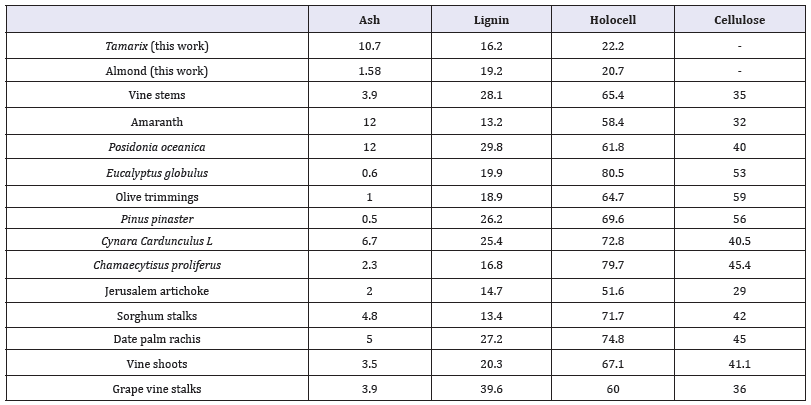- Submissions

Full Text
Significances of Bioengineering & Biosciences
Chemical Composition of Tamarix and Almond Fibers
Nabawia Mechi and Mohamed Ammar Elimame Elaloui*
University of Gafsa, Tunisia
*Corresponding author:Mohamed Ammar Elimame Elaloui, Materials, Environment and Energy Laboratory, Faculty of Sciences of Gafsa, University of Gafsa, Tunisia
Submission: March 03, 2018; Published: June 06, 2018

ISSN 2637-8078Volume1 Issue5
Abstract
In this work, we investigated the chemical composition of two lignocellulosic materials, largely available in Tunisia, as a source of two cellulosic fibres, namely: tamarix and almond.
Chemical Composition
Table 1 presents the chemical composition of several cellulosic materials such as wood, non-wood plants; these data have been obtained from the literature. When compared with data for grapevine stalks or vine shoots, cellulose and holocellulose contents are relatively close [1]. The comparison with other wood and non-wood species confirms that the amounts of extractives in the vine stems are high. According to structural components, this tow plants are characterized by relatively low cellulose content and high amounts of lignin, whereas the content in holocellulose is quite comparable. Finally, the ash content was found to be around 4%, which is much higher than that of wood and in the same range than that of non-wood plants. Tamarix is characterized by a higher amount of asch than almond, which is due to his botanical original [2].
Table 1: Tenacity and elongation under dry and wet conditions.

In conclusion, the Tunisian Tamarix and Almond are characterized by low amounts of extractives, lignin, and relatively high cellulose content. Thanks to the acceptable amount of holocellulose, this biomass could be viewed as a potential source of cellulose for the production of cellulose derivatives, and of lignocellulosic fibres for fibre-reinforced composite materials or papermaking applications [3].
References
- Khiari R, Mhenni MF, Belgacem MN, Mauret E (2010) Chemical composition and pulping of date palm rachis and Posidonia oceanic-a comparison with other wood and non-wood fibre sources. Bioresour Technol 101(2): 775-780
- Moussaoui Y, Ferhi F, Elaloui E, Bensalem R, Belgacem MN (2011) Utilisation of astragalus armatus roots in papermaking. Bio Resources 6(4): 4969-4978.
- Manfred J (1993) Non-wood plant fibres, will there be a come-back in papermaking. Ind Crops Prod 2(1): 51-57.
© 2018 Mohamed Ammar Elimame Elaloui. This is an open access article distributed under the terms of the Creative Commons Attribution License , which permits unrestricted use, distribution, and build upon your work non-commercially.
 a Creative Commons Attribution 4.0 International License. Based on a work at www.crimsonpublishers.com.
Best viewed in
a Creative Commons Attribution 4.0 International License. Based on a work at www.crimsonpublishers.com.
Best viewed in 







.jpg)






























 Editorial Board Registrations
Editorial Board Registrations Submit your Article
Submit your Article Refer a Friend
Refer a Friend Advertise With Us
Advertise With Us
.jpg)






.jpg)













.bmp)
.jpg)
.png)
.jpg)














.png)

.png)



.png)






